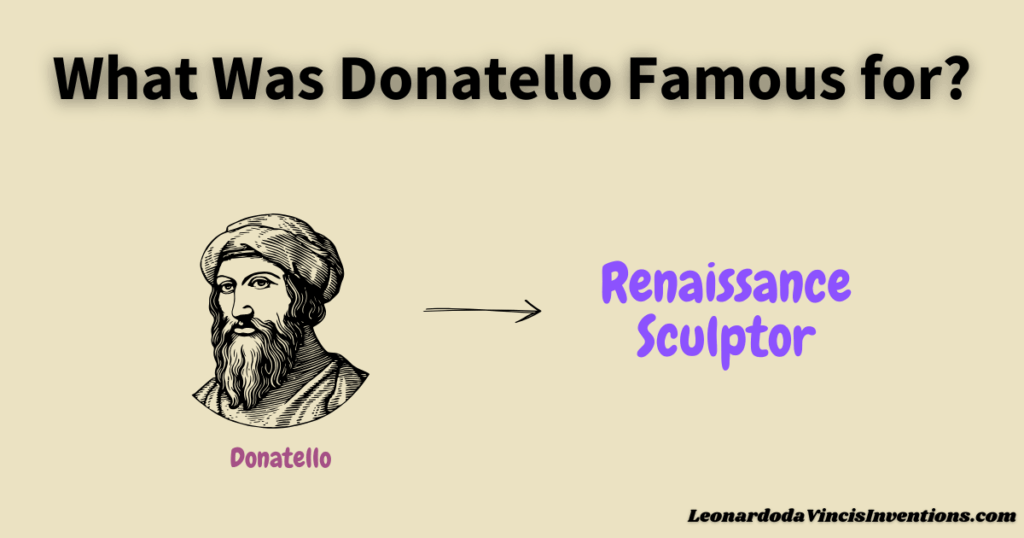
What was Donatello famous for?
His name appears in art history, but not everyone is familiar with the details. If you’ve wondered how one artist could shake up sculpture so much, let’s dig in and see what made him stand out.
Donatello became a leading sculptor of the Italian Renaissance, creating lifelike works like his bronze David and The Feast of Herod.
These pieces brought a level of emotion and realism that hadn’t been seen since ancient times, shifting art toward Renaissance ideals.
His marble and bronze sculptures are notable for their technical skill and profound impact. If you want the key details and some surprising facts, stick around.
Donatello started in Florence, but his influence spread across Italy. He changed how artists approached anatomy, movement, and storytelling in stone and metal.
By examining his most significant creations, you’ll understand why his impact on art history remains substantial.
The Dawn of a Renaissance Sculptor: Donatello’s Early Years and Artistic Foundations

Donatello’s journey as a sculptor began in Florence, a city renowned for its artistic innovation. His early life, surroundings, and mentors shaped a talent that would eventually transform Renaissance sculpture through the use of realism and storytelling.
The Birth of the Italian Renaissance and Its Artistic Movement
The Italian Renaissance was a period of cultural rebirth, highlighting the individual. Florence, packed with wealth and innovation, became the center of this movement.
Artists and thinkers turned away from medieval traditions, drawing inspiration from ancient Rome and Greece. Donatello stood at the front of this artistic movement, focusing on realistic human forms and emotional expression.
From his earliest works, he helped define the Renaissance as a time when art told stories and valued detailed realism. His naturalism made him a pioneer.
The Cradle of Early Renaissance Art and the Florence Art Scene
Florence was the birthplace of Early Renaissance art. The city offered resources and audiences for creative breakthroughs, especially in sculpture.
Guilds, churches, and wealthy traders pushed artists to experiment and perfect their skills. Donatello’s career flourished alongside the vibrant Florence art scene, where competition and mutual support fostered innovative ideas.
He gained access to marble and bronze and had the opportunity to observe other masters at work. Florence’s focus on realism and public art allowed Donatello to blend Classical themes with storytelling.
Apprenticeship and Early Influences: Classical Sculpture and Humanism
As a young artist, Donatello apprenticed with Ghiberti, a master goldsmith and sculptor. He learned the techniques of lost-wax bronze casting, precision carving, and the study of classical sculpture.
He also soaked up the values of Humanism, focusing on the beauty and individuality of people. Inspired by Greek and Roman statues, he explored realistic proportions and lifelike detail.
Donatello’s attention to youthful confidence and expressive faces set new standards. He often chose mythological and biblical subjects to convey human emotion, as seen in his later bronze sculpture of David.
The Medici Family: Patrons of Artistic Innovation and Storytelling Through Art
The Medici family ruled Florence and significantly influenced the city’s cultural development. As powerful bankers and art lovers, they supported many artists, including Donatello.
Their patronage provided him with the resources and freedom to experiment. This support allowed Donatello to develop ways to tell stories and convey emotion in stone and bronze.
His works for the Medici showed not just technical skill but also a knack for storytelling. Their partnership led to projects like the Marble Cantoria (singing gallery).
Artistic Periods: From Early to Middle Renaissance Sculptural Mastery
Donatello’s early years showed his skill with materials and creativity. He first got noticed with works like the Marble Cantoria, where a frieze of infants danced with emotion and realism.
This work reflected Early Renaissance ideals and mastery of surface detail. As he grew, Donatello pioneered depth, movement, and psychological drama in his art.
His middle period included bronze sculptures with dynamic poses and naturalistic details. Donatello’s influence extended from Florence to Padua as he transitioned from classical themes to deep, lifelike expression.
The Climax of Donatello’s Career: Masterpieces that Redefined Sculpture
Donatello hit his stride with works that changed how people saw sculpture. His knack for capturing human emotions and realism set new standards in the Italian art world.
Bronze David: The Icon of Youthful Confidence and Beauty
Donatello’s Bronze David stands as one of the first free-standing nude statues since ancient times. Made in Florence, this sculpture shows David with a relaxed stance and a sense of youthful confidence.
Unlike earlier versions, Donatello’s David isn’t idealized but looks natural and real. The Medici family commissioned this bronze sculpture, and it became a symbol for Florence.
The slight smile and smooth form reveal a human-centric view, blending both strength and innocence. Donatello’s use of bronze allowed fine details and lifelike qualities.
This David quickly became a standout piece in the world of Renaissance sculpture.
Marble Cantoria (Singing Gallery): A Testament to Artistic Narrative and Emotions
The Marble Cantoria, or singing gallery, is a large marble balcony made for Florence Cathedral. Donatello decorated it with a frieze of children singing and dancing.
These “putti” are shown in lively motion, full of joy and energy. Their faces and poses bring out strong artistic emotions rarely seen before.
With the Cantoria, Donatello showed his mastery of narrative. Scenes flow together, telling a story through expressive movement.
The detailed carving and deep relief create shadows, giving the figures depth and realism. This frieze of infants influenced later artists and is still admired for its mix of artistic innovation and skill.
David and Goliath: Classical Themes Reimagined with Humanistic Depth
In his David and Goliath works, Donatello drew on classical themes but reimagined them with new humanistic ideas. He focused on the moment after victory, showing David as thoughtful and human instead of just heroic.
This approach gave the story a more personal, relatable feel. Donatello included emotions and details that made the story more real.
His human-centered approach marked a big shift for the time. He showed classical sculpture influence but added Renaissance values—emotion, naturalism, and personal experience.
This shift helped define the era’s move toward storytelling through art.
Artistic Mastery in Bronze Sculpture and Realistic Human Forms
Donatello proved his talent for bronze work in Florence and Padua. He created realistic human forms with lifelike muscles, natural movement, and careful anatomy.
Works such as the Gattamelata equestrian statue in Padua were major breakthroughs. Bronze let him show details like folds in clothing and muscle tension.
Donatello’s focus on naturalism set new standards for sculptors. His technical and creative achievements made him a leading artist of the Italian Renaissance.
Artistic Legacy: How Donatello Shaped the Italian Renaissance and Beyond
Donatello’s influence on the Italian Renaissance shows in the work of later artists. His drive for artistic realism and storytelling shaped how others approached sculpture.
He moved art away from stiff, formal styles and toward pieces that showed real human experiences. The changes he made—using new materials, focusing on emotion, and blending old and new ideas—created an artistic legacy that lasted for centuries.
Artists like Michelangelo built on Donatello’s foundation. He was a true pioneer in the artistic movement that defined a new era in Europe. For more on his influence, check out this overview of Donatello’s masterpieces.
Who Won and Why It Matters: Donatello’s Enduring Influence in Art and Culture
Donatello’s work stands as a marker of artistic innovation and human-centric thinking in the Italian Renaissance. His achievements set new standards for realistic human forms and influenced major cultural movements.
He shaped the spirit of places like Florence and Padua. Donatello transformed how sculpture was created and seen during the Renaissance.
Artistic Breakthroughs that Changed Sculpture Forever
He’s best known for his bronze David, the first freestanding nude male sculpture since ancient times. This artwork revived classical sculpture and brought a new level of realism and personality to art.
His marble Cantoria (the “singing gallery”) features a frieze of infants in lively, dynamic motion. This broke away from the stiff, flat style of the Gothic period.
Donatello’s ability to show real emotions and energy in his figures became a model for future sculptors. He mastered bronze, marble, and wood, showing what each material could do.
His works clearly mark a turning point between Medieval and Renaissance art—one that emphasized artistic mastery and breakthroughs in naturalism.
The Humanism Movement and Its Role in Donatello’s Work
The Italian Renaissance saw Humanism take center stage. This movement focused on human experience, emotions, and individual potential.
Donatello played a big role in bringing these ideas into art. Through lifelike expressions and natural postures, his sculptures—especially the bronze David—celebrated youthful confidence and beauty.
The focus shifted from religious symbolism to more relatable characters. Donatello championed a human-centric view, with sculptures that invited people to connect with the figures personally.
His approach bridged ancient classical themes with the new Humanist spirit. The result? Art that felt alive and deeply tied to everyday experience.
The Broader Impact on Florence, Padua, and the Renaissance World
Donatello lived and worked in Florence. The city buzzed with creativity, and his art quickly found strong supporters, especially the powerful Medici family.
They commissioned iconic pieces like the bronze David. Later, Donatello moved to Padua and left his mark on artists in Northern Italy too.
His presence energized local art scenes and sparked new ideas about sculpture and realism. These cities grew into hubs for bold artistic movements.
Donatello’s work pushed the limits of sculpture. He set a new standard for artistic realism that rippled out across Europe.
The Artistic Narrative of Donatello’s Life and Career: A Story of Rising Action and Resolution
Donatello’s artistic journey unfolded in stages: early, middle, and late periods. In the beginning, he focused on learning and experimenting with stone and bronze.
His middle period brought signature pieces like the marble Cantoria and the bronze David. Each new work felt more daring, full of emotion and movement.
He got more ambitious, weaving storytelling into his art. Even near the end, Donatello kept pushing himself to innovate.
He explored complex religious themes and psychological depth. His late works showed a sense of maturity and artistic resolution.
Why Donatello’s Fame Still Matters Today
Donatello stands out as one of the most important figures in art history. His focus on realism, emotion, and the human form shaped the Renaissance and modern sculpture alike.
Public collections around the world display his masterpieces. His techniques still spark inspiration in artists today.
Works like the bronze David and marble Cantoria get celebrated for their innovation and naturalism. Donatello showed that art could tell powerful stories—connecting past and present, and offering new ways to see ourselves and our history.
Want to dive deeper into Donatello’s influence? Check out Donatello’s Influence: Shaping Renaissance Art and Beyond and the Metropolitan Museum of Art for more reading.
Final Thoughts
What was Donatello famous for, if not his lasting influence on Renaissance sculpture? He introduced realistic movement and emotion—pretty wild for his era.
His work with marble and bronze really set him apart. The bronze “David” stands out, its pose breaking away from the stiff styles that came before.
Donatello worked with major art patrons, including the Medici family. His busts and reliefs show an eye for detail and a real understanding of the human form.
Key Takeaways:
- Donatello brought life and naturalism to sculpture.
- His innovative techniques and partnerships left a major mark on the art world.
If you want to see other famous sculptors or Renaissance artworks, take a look at Britannica and Artst. The question of what Donatello was famous for will always matter to anyone digging into the evolution of European art.
Frequently Asked Questions
Donatello led the way as a sculptor in the Italian Renaissance. He changed the look of art with his work in bronze and marble, influencing many artists who followed.
What is Donatello best known for?
Donatello is best known for his sculptures, especially his bronze statue of David. That piece was the first freestanding nude statue made since ancient times.
He’s also admired for adding lifelike details and emotional expressions to his art.
What are 10 facts about Donatello?
- Donatello was born around 1386 in Florence, Italy.
- He worked with both marble and bronze.
- He made the famous bronze David.
- Donatello also created religious pieces like the Madonna of the Clouds.
- His full name was Donato di Niccolò di Betto Bardi.
- He was famous during his own lifetime.
- He worked for powerful families in Florence.
- Donatello helped develop the technique of shallow relief.
- His art showed real human feelings and anatomy.
- He died in 1466 in Florence.
What is Donatello remembered for?
Donatello is remembered as a master sculptor in marble and bronze. He introduced new levels of realism and emotion, setting himself apart from earlier artists.
His work shaped the direction of Renaissance sculpture.
What did Donatello inspire many artists to do?
Donatello’s attention to detail inspired later artists to focus on realistic human bodies and emotions. He proved that sculptures could tell stories and express deep feelings, which had a big effect on art in the Renaissance and beyond.
What is Donatello’s masterpiece?
His most famous sculpture is the bronze statue of David. This statue broke new ground as the first large freestanding nude since ancient times.
It showed a young David after his victory over Goliath.
Was Donatello religious?
Many of Donatello’s works were religious, like his Madonnas and saints. He created art for churches and chapels, often showing scenes from the Bible or featuring holy figures.
Why is Donatello still important?
Donatello changed how artists made sculptures by introducing lifelike figures and using new techniques. He helped kick off the Renaissance movement in Italy.
Museums still display his works, and students keep learning about his influence on Western art.
What is Raphael’s most famous painting called?
Raphael’s most famous painting is the School of Athens. It shows great philosophers of ancient Greece and is known for its balanced composition.
Who is better Michelangelo or Donatello?
Michelangelo and Donatello were both great sculptors. Michelangelo is known for his size and power, while Donatello stands out for realism and creativity.
Honestly, it’s tough to compare—both shaped art history in their own ways.
How did Donatello influence Leonardo da Vinci?
Donatello really cared about accurate anatomy and life-like details, and that inspired Leonardo da Vinci. His new sculpting styles nudged others, including Leonardo, to look closer at human structure and show more emotion in their art.



 Leonardo Bianchi,
the creator of Leonardo da Vinci's Inventions.
Thank you for visiting
Leonardo Bianchi,
the creator of Leonardo da Vinci's Inventions.
Thank you for visiting